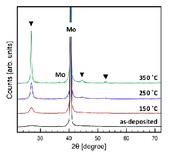Highlight
Solution-deposition of Cu(In,Ga)Se2 solar cell by on hydrazine precursors
Achievement/Results
The research done by Wei-Jen Hou in the Yang Yang group has contributed to the understanding of hydrazine-based solution chemistry as well as the its application in photovoltaic cells. Using hydrazine as a solvent, CuInSe2 can be solution-deposited at temperature as low as 350 °C. The structural evolution of the precursor film when annealed from 50 °C to 350 °C is shown in the figure below (Figure 1). The XRD pattern indicated a CuInSe2 structure with an estimated grain size of 45 nm based on the Scherer’s equation. The solar cell was fabricated on glass substrate using CuInSe2 as the active layer following by CdS by chemical bath deposition, ZnO and ITO by sputtering. This low-temperature processing provides a viable potential to fabricate cells on polyimide substrates. With further tuning in the absorber layer to enhance the carrier collection near the back-contact, we believe that the photovoltaic performance of cells fabricated using our methodology can be further improved. A description of the research progress of this research for the past two years is shown in Figure 2. This research received worldwide coverage in 50+ media including Scientific American, The New York Times, World Journal, and China.
References:
Hou, W., Bob, B., Li, S.H., & Yang, Y. (2009). Low-temperature processing of solution-deposited CuInSxSe1-x solar cell. Thin Solid Films 517, 6853. Exotic Solar Cells Get Cheaper. Scientific American July 8, 2009.
Breakthrough Reported on Low-cost Alternative to Silicon Solar Cells. The New York Times.
Address Goals
The Hydrazine-based precursors offer a great method to solution-deposit various inorganic semiconductors with great electrical property. The hydrazine-based Cu(In,Ga)Se2 film has demonstrated great photovoltaic property and opens a new door to low-cost processing of solar cells.







